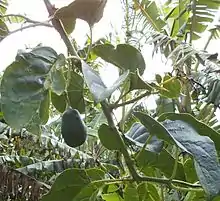Solanum sibundoyense
Solanum sibundoyense is a species of plant in the family Solanaceae. It is endemic to Colombia, specifically to Sibundoy and surrounding areas, and usually resides in cloud forests, 1400–2300 meters in elevation. It is also known as tomate salvaje or tomate silvestre to natives of Colombia, and also sometimes called Cyphomandra sibundoyensis.[2][3] It's a small tree 4–8 m tall. Stems glabrous or sparsely puberulent with glandular and eglandular hairs less than 0.5 mm long.
| Solanum sibundoyense | |
|---|---|
 | |
| The immature fruit and leaves of Solanum sibundoyense | |
| Scientific classification | |
| Kingdom: | Plantae |
| Clade: | Tracheophytes |
| Clade: | Angiosperms |
| Clade: | Eudicots |
| Clade: | Asterids |
| Order: | Solanales |
| Family: | Solanaceae |
| Genus: | Solanum |
| Species: | S. sibundoyense |
| Binomial name | |
| Solanum sibundoyense (Bohs) Bohs | |
Uses
The fruits are edible and have a pleasant acidulous taste.[4] The plant produces some of the largest fruits known in section Pachyphylla. The fruit pulp of some trees is sweet, juicy, and pleasant-tasting,[5] and in others it is acidulous, and without any sweetness.[6] A purplish layer of soft pulp surrounds the seeds. Fruits ripen slowly, but once ripe their shelf life is longer than that of the tamarillo. Although a good candidate for trial as a fruit crop, it may be difficult to successfully cultivate this species outside the specialized climate of southern Colombia where it is native.[5] In New Zealand, it was noted that trees cultivated in semi-shade set large crops of fruit, but plants grown in full sun performed very poorly. The trees were somewhat subject to branch die-back on fruiting branches.[6]
Historically, the fruit has been used to make black, blue, or yellow dye by the natives of the Sibundoy Valley of southern Colombia. Some sources show that the placenta of the fruit may be used as a cure for intestinal worms. Schultes and Raffauf (1990) report that the Kamsá Indians of the Sibundoy Valley (southwestern Colombia) use a decoction of the leaves for this purpose.[5]
References
- World Conservation Monitoring Centre (1998). "Solanum sibundoyense". IUCN Red List of Threatened Species. 1998: e.T35477A9934763. doi:10.2305/IUCN.UK.1998.RLTS.T35477A9934763.en.
- Cyphomandra sibundoyensis Bohs, Syst. Bot. 13: 273. 1988.
- Bohs, L. 1995. Transfer of Cyphomandra (Solanaceae) and its species to Solanum. Taxon 44: 583-587.
- Bohs, L. 1994. Cyphomandra (Solanaceae). Flora Neotropica Monograph 63, New York Botanical Garden, page 134.
- Bohs, Lynn (5 July 1994). "Cyphomandra (Solanaceae)". Flora Neotropica. Monograph 63: 134.
- Meadows, Laurie. "Growing rare Tamarillo relatives (Cyphomandra species) in New Zealand". WWW.naturalhub.com. Retrieved 6 December 2012.
